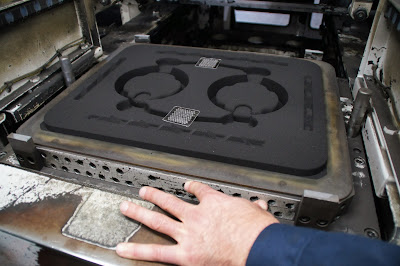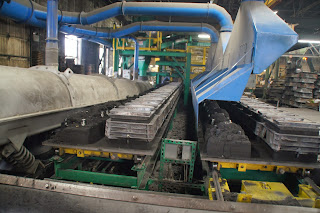 |
| This bag of additives is added in the machine pictured next. |
 |
| The Speedmullor which mixes the ingredients and is controlled by the computerized panel. |
 |
| Inside the mullor the ingredients are being mixed. |
 |
| Jerry and his employee Rob are examining the operation of the computer on the Speedmullor. |
 |
| This shows the bottom half of the flask after it has been packed with sand. The pattern has been removed and you can now see what the casting will look like after it has been cast in metal. |
 |
| This is the area where the metal is heated until it is liquefied. |
 |
| These are bronze ingots that will melt at 1750 degrees. Bronze is composed of copper and zinc. The ingots are placed in the crucible that is usually silicon carbide. |
 |
| Here foundry pourer Ed is removing the dross from the molten metal. |
 |
| Ed is preparing to load the crucible into the pouring bail that will carry the hot molten metal to the conveyor that holds the flasks. |
 |
| He uses an overhead transportation system for moving the crucible. Notice the ventilation mask and gloves that are needed. |
 |
| Pouring the metal! Remember it is at least 1750 degrees at this point. |
 |
| The molds on the right will be taken apart and the sand and casting will be placed next to it to proceed to the next step. |
 |
| Here Luis, under heavy protection, cuts the casting off the gating system. |
 |
| This worker is grinding any imperfections off of the casting. The buyer of the product will take it from this stage and machine it to the specific dimensions that they need. |
 |
| Photo of Jason on the left and Jerry as then stand in front of the Roberts Sinto machine. Jerry is the owner of Flury Foundry and will eventually pass it on to his his nephew Jason. |





No comments:
Post a Comment